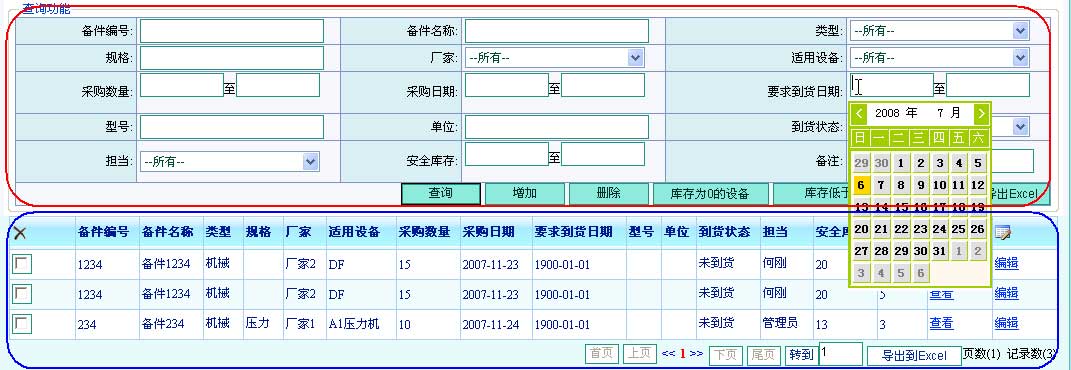本文转自:http://www.cnblogs.com/wuhuacong/archive/2008/07/06/1235576.html
接着上一篇关于分层架构的讨论,一个分层架构设计的例子(1)。
上篇介绍了实体类(Entity)、数据库访问类(DAL)、数据访问接口(IDAL)的相关设计,本篇主要讨论下面几个部分内容:业务逻辑层、缓存机制、界面层等方面。
业务逻辑层,主要是业务逻辑基类的设计,由于数据库访问类(DAL)的基类封装了大量的操作实现,因此,业务逻辑层的主要工作是进一步封装对底层访问接口的实现,如下所示。
 public class BaseBLL<T> where T : BaseEntity, new()
public class BaseBLL<T> where T : BaseEntity, new() {
{ 构造函数
构造函数
 对象添加、修改、删除等接口
对象添加、修改、删除等接口
 返回集合的接口
返回集合的接口 }
}
业务层基类封装了大量的调用,那么对于业务层的具体操作类,它的工作就很简单了,基本上只需要继承一下基类就可以了,这就是有一个优秀父亲的好处,呵呵
 public class Equipment : BaseBLL<EquipmentInfo>
public class Equipment : BaseBLL<EquipmentInfo> {
{ public Equipment() : base()
public Equipment() : base() {
{ }
} }
}
基本上,业务层的设计到此应该收尾了,可是我们注意到,很多开发都使用了缓存的机制来进一步提高程序的性能,下面对这方面进行讨论。缓存的机制,一般是把创建过的对象资源放到一个集合中,需要的时候,调出来,如下业务层的工厂类所示。
 public class BLLFactory<T> where T : class
public class BLLFactory<T> where T : class {
{ private static Hashtable objCache = new Hashtable();
private static Hashtable objCache = new Hashtable(); public static T Instance
public static T Instance {
{ get
get {
{ string CacheKey = typeof(T).FullName;
string CacheKey = typeof(T).FullName; T bll = (T)objCache[CacheKey]; //从缓存读取
T bll = (T)objCache[CacheKey]; //从缓存读取  if (bll == null)
if (bll == null) {
{ bll = Reflect<T>.Create(typeof(T).Name, "HuaweiSoftware.IPSPBD.BLL"); //反射创建,并缓存
bll = Reflect<T>.Create(typeof(T).Name, "HuaweiSoftware.IPSPBD.BLL"); //反射创建,并缓存 }
} return bll;
return bll; }
} }
} }
}
这是一个业务逻辑类工厂创建类,我们在界面层只需要如下调用即可构造一个(利用了缓存)具体的业务类出来
 CustomerInfo info = BLLFactory<Customer>.Instance.FindByID(ID);
CustomerInfo info = BLLFactory<Customer>.Instance.FindByID(ID);
在上面的BaseBLL和BLLFactory类中,有一个Reflect的操作类,这是反射缓存的具体实现所在,我们探讨一下它的实现。
 public class Reflect<T> where T : class
public class Reflect<T> where T : class  {
{ private static Hashtable m_objCache = null;
private static Hashtable m_objCache = null; public static Hashtable ObjCache
public static Hashtable ObjCache {
{ get
get {
{ if (m_objCache == null)
if (m_objCache == null) {
{ m_objCache = new Hashtable();
m_objCache = new Hashtable(); }
} return m_objCache;
return m_objCache; }
} }
}
 public static T Create(string sName, string sFilePath)
public static T Create(string sName, string sFilePath) {
{ return Create(sName, sFilePath, true);
return Create(sName, sFilePath, true); }
} public static T Create(string sName, string sFilePath, bool bCache)
public static T Create(string sName, string sFilePath, bool bCache) {
{ string CacheKey = sFilePath + "." + sName;
string CacheKey = sFilePath + "." + sName; T objType = null;
T objType = null; if (bCache)
if (bCache) {
{ objType = (T)ObjCache[CacheKey]; //从缓存读取
objType = (T)ObjCache[CacheKey]; //从缓存读取  if (!ObjCache.ContainsKey(CacheKey))
if (!ObjCache.ContainsKey(CacheKey)) {
{ Assembly assObj = CreateAssembly(sFilePath);
Assembly assObj = CreateAssembly(sFilePath); object obj = assObj.CreateInstance(CacheKey);
object obj = assObj.CreateInstance(CacheKey); objType = (T)obj;
objType = (T)obj;
 ObjCache.Add(CacheKey, objType);// 写入缓存 将DAL内某个对象装入缓存
ObjCache.Add(CacheKey, objType);// 写入缓存 将DAL内某个对象装入缓存 }
} }
} else
else {
{ objType = (T)CreateAssembly(sFilePath).CreateInstance(CacheKey); //反射创建
objType = (T)CreateAssembly(sFilePath).CreateInstance(CacheKey); //反射创建  }
}
 return objType;
return objType; }
}
 public static Assembly CreateAssembly(string sFilePath)
public static Assembly CreateAssembly(string sFilePath) {
{ Assembly assObj = (Assembly)ObjCache[sFilePath];
Assembly assObj = (Assembly)ObjCache[sFilePath]; if (assObj == null)
if (assObj == null) {
{ assObj = Assembly.Load(sFilePath);
assObj = Assembly.Load(sFilePath); ObjCache.Add(sFilePath, assObj);//将整个DLL装入缓存
ObjCache.Add(sFilePath, assObj);//将整个DLL装入缓存 }
} return assObj;
return assObj; }
} }
}
另外,如果你在业务层需要实现更加复杂的功能,而数据库访问基类BaseDAL提供的函数不能满足你的需要,可以扩展数据访问层的接口和实现,如下所示。
 public interface ICustomer : IBaseDAL<CustomerInfo>
public interface ICustomer : IBaseDAL<CustomerInfo> {
{ List<string> GetAllCustomerNumber();
List<string> GetAllCustomerNumber();
 CustomerInfo GetByCustomerNumber(string number);
CustomerInfo GetByCustomerNumber(string number); }
}

 public class Customer : BaseDAL<CustomerInfo>, ICustomer
public class Customer : BaseDAL<CustomerInfo>, ICustomer {
{ 对象实例及构造函数
对象实例及构造函数








 ICustomer 成员
ICustomer 成员 }
}
那么在业务层的类修改如下
 public class Customer : BaseBLL<CustomerInfo>
public class Customer : BaseBLL<CustomerInfo> {
{ public Customer() : base()
public Customer() : base() {
{ }
}
 public List<string> GetAllCustomerNumber()
public List<string> GetAllCustomerNumber() {
{ ICustomer customerDAL = baseDal as ICustomer;
ICustomer customerDAL = baseDal as ICustomer; return customerDAL.GetAllCustomerNumber();
return customerDAL.GetAllCustomerNumber(); }
}
 public CustomerInfo GetByCustomerNumber(string number)
public CustomerInfo GetByCustomerNumber(string number) {
{ ICustomer customerDAL = baseDal as ICustomer;
ICustomer customerDAL = baseDal as ICustomer; return customerDAL.GetByCustomerNumber(number);
return customerDAL.GetByCustomerNumber(number); }
} }
}
最后,界面方面的设计是见仁见智,但根本一条是利用一些控件,可以统一风格,减少劳动,给出几个界面的设计截图供大家参考
WinForm方面的(颜色标明的是使用了特定的界面控件,其中红色部分为和整个架构整合起来的分页控件,集成了一些基本的右键菜单操作,包括打印功能、数据导出功能等):
Winform分页控件设计视图
可以选择列进行打印
在实际运用过程中的界面效果
WebForm方面的(可以使用之前文章介绍的查询控件、分页控件、内容编辑控件):
下图是查询控件和分页控件的一起运用:
修改内容时候的编辑控件
查看内容时候的编辑控件
以上所引用的代码是通过代码生成工具Database2Sharp自动生成(http://www.iqidi.com/Database2Sharp.htm),选择EnterpriseLibrary架构即可。


